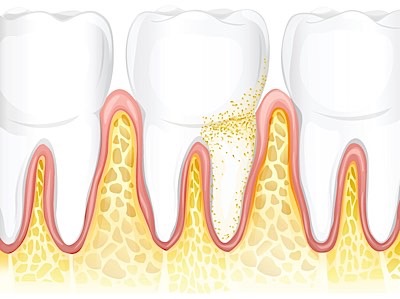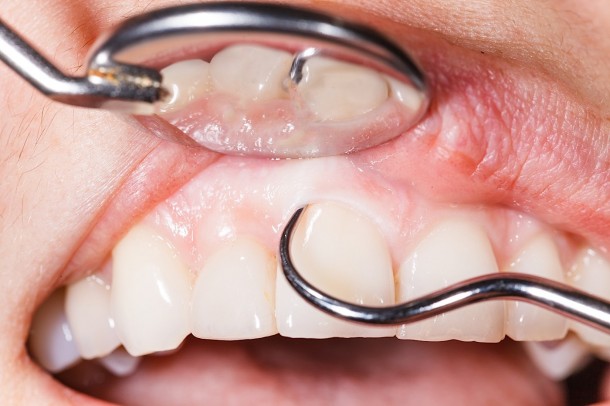Are your gums healthy?
Periodontal disease, also known as gum disease, is a bacterial infection of the tissues surrounding and supporting the teeth. It is a very serious disease as it can result in tooth loss and cause systemic health problems such as placing you at a higher risk for stroke and heart disease. It is typically a painless disease, but there are signs of the disease that you can recognize.
Six signs of periodontal disease:
- An unhealthy smile, in which the gums pull back or recede from your teeth.
- Offensive bad breath.
- Gums become puffy, red, and bleed when you brush or floss.
- Teeth that become loose.
- Pus between the teeth and gums when the gums are pressed.
- Changes in the way your teeth bite or fit together.
*Know that it is NOT normal for you gums to bleed when brushing or flossing your teeth!!!!

What causes gum disease?

Gum disease is caused by bacteria that form into plaques on your teeth. The plaque builds up on your teeth near the gum line constantly throughout the day. The gums become swollen and red, which is the initial sign of infection. This is called gingivitis and this condition is reversible. If the plaques are not removed from the teeth on a regular basis, the bacteria move deeper into the gums progressing into an irreversible disease called periodontitis. It is at this stage when the bacteria eat away at the tissues and surrounding bone that hold your teeth in place. This stage of the disease can be arrested, but if it is not caught early enough it will result in tooth loss. Eventually, late stage periodontal disease will cause pain and your teeth will become loose.
Risk factors for gum disease
There are two major ways to prevent gum disease. First, brushing and flossing your teeth on a daily basis will prevent plaque formation and prevent the bacteria from invading your gums. We recommend brushing twice a day totaling 4-5 minutes and flossing once a day. We often times recommend electric toothbrushes to our patients because it does a very efficient and effective job removing the plaques. In addition, it helps people brush more gently who currently brush too hard. The second major way to prevent gum disease is to see your hygienist and dentist on a regular basis. This purpose is two-fold. First, your dental team will be able to recognize early signs of gum disease and treat it appropriately before irreversible damage occurs. The second reason is that only the hygienist can remove the hardened plaques called calculus or tartar that can form above and below your gums.
How does your dental team diagnose gum disease?
 First we will review your dental and medical history. We will then discuss any medications or existing conditions that might affect the health of your gums. Second, we will evaluate your gums by periodontal probing to check how much tissue attachment you have surrounding your teeth. Pockets greater than 3 mm are potential areas of gum disease. These are areas that tissue loss has occurred. Finally, we will evaluate your radiographs, which are indispensable to properly diagnose the disease. The proper x-rays are needed to view bone levels and any destruction caused by the disease.
First we will review your dental and medical history. We will then discuss any medications or existing conditions that might affect the health of your gums. Second, we will evaluate your gums by periodontal probing to check how much tissue attachment you have surrounding your teeth. Pockets greater than 3 mm are potential areas of gum disease. These are areas that tissue loss has occurred. Finally, we will evaluate your radiographs, which are indispensable to properly diagnose the disease. The proper x-rays are needed to view bone levels and any destruction caused by the disease.
How is gum disease treated?
Gum disease is treated differently for each individual case. The treatment depends on the severity of the disease as well as the location of the disease in the mouth. Treatment includes more frequent cleanings, deep cleanings called scaling and root planning, antibiotic therapy, and tooth extractions just to name a few.
For more questions about gum disease or to have yourself evaluated for gum disease please call our office at (586) 978-8233 to schedule an appointment.

